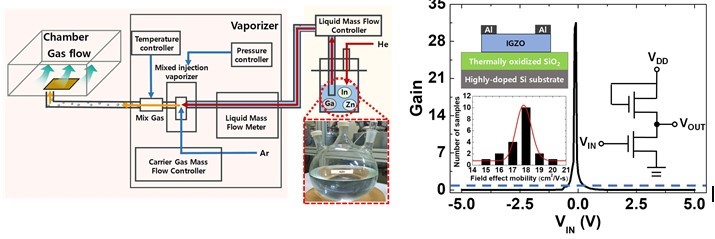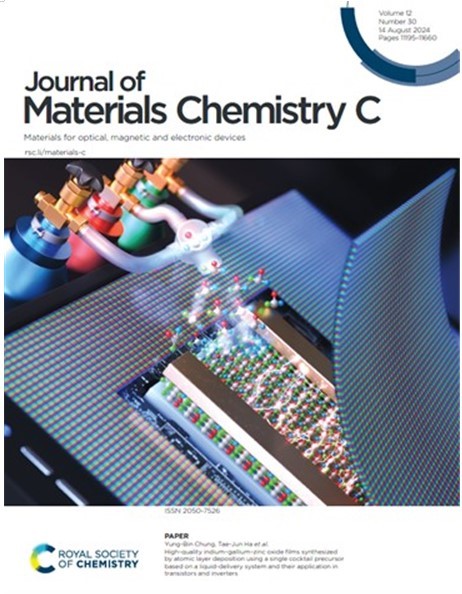Prof. Tae-Jun Ha's Research Team Implements Indium-gallium-zinc Oxide Thin-film Transistors
- admin
- 2024-09-13
- 1800
· Professor Tae-Jun Ha's Research Team (Department of Electronic Materials Engineering) Implements Indium-gallium-zinc Oxide Thin-film Transistors and Inverters
Based on Atomic Layer Deposition Using a
Single Mixed Precursor
- Published
as an Inside Front Cover in the internationally renowned journal Journal of
Materials Chemistry C

(From left) Sang-Jun Park, MS-PhD integrated
program; Se-Ryong Park, MS-PhD integrated program; Professor Tae-Jun Ha
Professor Tae-Jun Ha's research team
(Department of Electronic Materials Engineering) successfully optimized the
atomic layer deposition (ALD) process for fabricating indium-gallium-zinc oxide
(IGZO) thin films using a liquid-delivery system with a single mixed precursor.
They used this process to implement thin-film transistors and inverters with
high mobility and voltage gain. This research, titled 'High-quality
indium-gallium-zinc oxide films synthesized by atomic layer deposition using a
single cocktail precursor based on a liquid-delivery system and their
application in transistors and inverters,' was published in the Journal of
Materials Chemistry C (IF: 6.4, JIF ranking: 80.3%), an internationally
renowned journal in the field of applied physics by the Royal Society of
Chemistry, and was selected for the Inside Front Cover.
(Reference:
https://doi.org/10.1039/D4TC01843E)
Atomic layer
deposition (ALD) technology has recently gained significant attention for the
high-quality deposition of IGZO thin films, which are widely used as oxide
semiconductors in the channel layer of oxide thin-film transistors. However,
for atomic layer deposition of four-component materials like conventional IGZO,
each metal precursor must be deposited separately, making the process complex,
deposition speed slow, and precise thickness control difficult. To address this
issue, Professor Tae-Jun Ha's research team (Department of Electronic Materials
Engineering), in collaboration with Samsung Display's Process Development
Research Team, successfully achieved the first atomic layer deposition of IGZO
thin films using a single mixed precursor based on a liquid-delivery system.
The synthesized IGZO thin film exhibited high quality, including low surface
roughness and a high metal-oxygen bonding ratio, and was used to implement oxide
thin-film transistors and inverters based on the optimized process technology. The
fabricated thin-film transistor, based on the high-quality IGZO thin
film, exhibited a high mobility of over 20 cm² V?¹ s?¹ at an operating voltage of 5 V. Due to the low
oxygen vacancy defects, it also maintained stable operating characteristics
under bias stress for 20,000 seconds. Additionally, by applying the IGZO
thin-film transistor, the team successfully implemented an NMOS inverter with a
voltage gain of 31.48 and a noise margin of 0.2 V.
Meanwhile, this
research was the result of a collaborative effort between the Process
Development Research Team at Samsung Display, a client company, and the
Interactive Display Research Center, led by Professor Tae-Jun Ha as the
director, under the Kwangwoon University Innovation Future Challenge Project.
The project was supported by the Carbon Neutral Industrial Core Technology
Development Project, supervised by the Ministry of Trade, Industry, and Energy,
and the New Product Development Program under Purchase Conditions, supervised
by the Ministry of SMEs and Startups. Sang-Jun Park, the first author and an
MS-PhD integrated program student, has been conducting research on
next-generation semiconductor materials and electronic application devices
since 2023, supported by the Research Scholarship for Doctoral Students from
the Next-Generation Science and Technology Scholars Program. After obtaining
his PhD from the university this August, he is set to join the IT Development Team
of the Small and Medium Display Division at Samsung Display.

Atomic layer deposition of IGZO thin films using a liquid-delivery system with a single mixed precursor, and performance analysis of thin-film transistors and inverters based on it

Cover paper
published in Journal of Materials Chemistry C
?